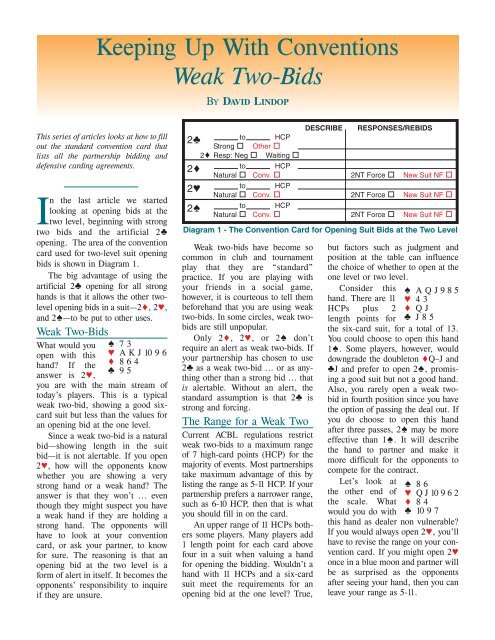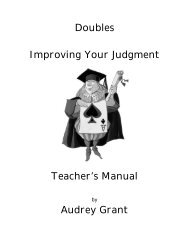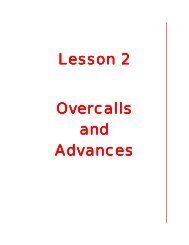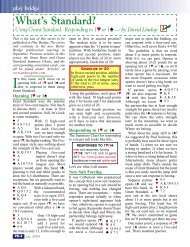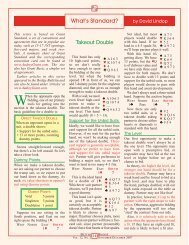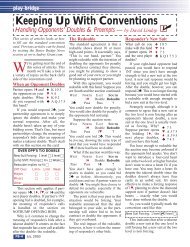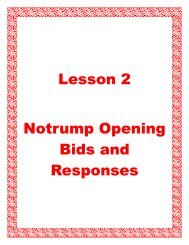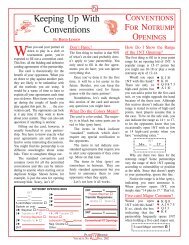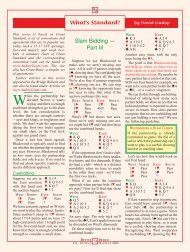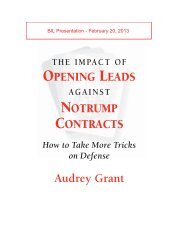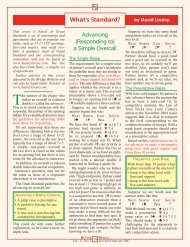Keeping Up With Conventions Weak Two-Bids - Better Bridge
Keeping Up With Conventions Weak Two-Bids - Better Bridge
Keeping Up With Conventions Weak Two-Bids - Better Bridge
You also want an ePaper? Increase the reach of your titles
YUMPU automatically turns print PDFs into web optimized ePapers that Google loves.
<strong>Keeping</strong> <strong>Up</strong> <strong>With</strong> <strong>Conventions</strong><strong>Weak</strong> <strong>Two</strong>-<strong>Bids</strong>BY DAVID LINDOPThis series of articles looks at how to fillout the standard convention card thatlists all the partnership bidding anddefensive carding agreements.In the last article we startedlooking at opening bids at thetwo level, beginning with strongtwo bids and the artificial 2opening. The area of the conventioncard used for two-level suit openingbids is shown in Diagram 1.The big advantage of using theartificial 2 opening for all stronghands is that it allows the other twolevelopening bids in a suit—2, 2,and 2—to be put to other uses.<strong>Weak</strong> <strong>Two</strong>-<strong>Bids</strong>What would youopen with thishand? If theanswer is 2, 7 3 A K J 10 9 6 8 6 4 9 5you are with the main stream oftoday’s players. This is a typicalweak two-bid, showing a good sixcardsuit but less than the values foran opening bid at the one level.Since a weak two-bid is a naturalbid—showing length in the suitbid—it is not alertable. If you open2, how will the opponents knowwhether you are showing a verystrong hand or a weak hand? Theanswer is that they won’t ... eventhough they might suspect you havea weak hand if they are holding astrong hand. The opponents willhave to look at your conventioncard, or ask your partner, to knowfor sure. The reasoning is that anopening bid at the two level is aform of alert in itself. It becomes theopponents’ responsibility to inquireif they are unsure.2to HCPStrong Other 2 Resp: Neg Waiting <strong>Weak</strong> two-bids have become socommon in club and tournamentplay that they are “standard”practice. If you are playing withyour friends in a social game,however, it is courteous to tell thembeforehand that you are using weaktwo-bids. In some circles, weak twobidsare still unpopular.Only 2, 2, or 2don’trequire an alert as weak two-bids. Ifyour partnership has chosen to use2 as a weak two-bid ... or as anythingother than a strong bid ... thatis alertable. <strong>With</strong>out an alert, thestandard assumption is that 2 isstrong and forcing.The Range for a <strong>Weak</strong> <strong>Two</strong>Current ACBL regulations restrictweak two-bids to a maximum rangeof 7 high-card points (HCP) for themajority of events. Most partnershipstake maximum advantage of this bylisting the range as 5-11 HCP. If yourpartnership prefers a narrower range,such as 6-10 HCP, then that is whatyou should fill in on the card.An upper range of 11 HCPs botherssome players. Many players add1 length point for each card abovefour in a suit when valuing a handfor opening the bidding. Wouldn’t ahand with 11 HCPs and a six-cardsuit meet the requirements for anopening bid at the one level? True,DESCRIBERESPONSES/REBIDS2to HCPNatural Conv. 2NT Force New Suit NF 2to HCPNatural Conv. 2NT Force New Suit NF to HCP2Natural Conv. 2NT Force New Suit NF Diagram 1 - The Convention Card for Opening Suit <strong>Bids</strong> at the <strong>Two</strong> Levelbut factors such as judgment andposition at the table can influencethe choice of whether to open at theone level or two level.Consider thishand. There are 11HCPs plus 2length points for J 8 5the six-card suit, for a total of 13.You could choose to open this hand1. Some players, however, woulddowngrade the doubleton Q–J andJ and prefer to open 2, promisinga good suit but not a good hand.Also, you rarely open a weak twobidin fourth position since you havethe option of passing the deal out. Ifyou do choose to open this handafter three passes, 2 may be moreeffective than 1. It will describethe hand to partner and make itmore difficult for the opponents tocompete for the contract.Let’s look atthe other end ofthe scale. Whatwould you do with A Q J 9 8 5 4 3 QJ 8 6 Q J 10 9 6 2 8 4 10 9 7this hand as dealer non vulnerable?If you would always open 2, you’llhave to revise the range on your conventioncard. If you might open 2once in a blue moon and partner willbe as surprised as the opponentsafter seeing your hand, then you canleave your range as 5-11.
In summary, you can indicatethat you play weak two-bids bychecking “Natural” and filling inthe range like this:25 to 11 HCPNatural √ Conv. 25 to 11 HCPNatural √ Conv. 25 to 11 HCPNatural √ Conv. Some players save time by simplyfilling out the details for 2 andthen using an arrow to indicate thatthis applies to 2 and 2 as well:25 to 11 HCPNatural √ Conv. 2to HCPNatural Conv. to HCP2Natural Conv. The Quality of the SuitWould you open2 with this hand?If so, you are playingundisciplined J 9 8 6 5 3 5 A 10 2 K 7 5weak twos ... the quality of the suitdoesn’t matter. Some partnershipsprefer a more disciplined approach,especially in first or second position... or fourth ... since partner mayhave to decide what to respond.A typical agreement might betwo of the top three honors in thesuit, or three of the top five. If that’syour agreement, you can write it inthe area under “DESCRIBE.” Ifyou don’t have a firm agreement,you can leave this area blank.The Length of the SuitWould you open 2 9 2with this hand? KQJ 95Most partnerships J 7 5 3prefer that a weak 6 4two promises a six-card suit. Evenso, you might occasionally openwith a good five-card suit, especiallyin third position ... when partnerhas already passed.That’s fair game but, if yourpartnership frequently opens a weaktwo-bid with a five-card suit, youshould write something like “5 or 6cards” under “DESCRIBE.”The 2NT ResponseWhat would yourespond with thishand if your partneropens 2 and thenext player passes? You may haveenough for game if opener has thetop of the range for the weak two-bidbut you may belong in partscore ifopener has a very weak hand.The standard approach is to use aresponse of 2NT to a weak two-bidas an artificial bid asking for a furtherdescription of opener’s hand.This is not alertable.After responder’s 2NT bid, onepopular style is for opener to show afeature in another suit ... typically anace or a king ... by bidding that suitwith the upper range for the weak twobid.<strong>With</strong> a minimum, opener simplyrebids the original suit. <strong>With</strong> a maximumbut no outside feature, openerrebids 3NT. This style of rebids is notalertable and would be indicated under“RESPONSES/REBIDS” this way:Feature2NT Force √If the partnership uses undisciplinedweak two-bids, another popularapproach is “Ogust.” Openeruses the following step responses tothe 2NT inquiry:3 5-8 points; bad suit.3 5-8 points; good suit.3 9-11 points; bad suit.3 9-11 points; good suit.Since each of these step responsesis totally artificial, these rebids arealertable. If your partnership usesthis approach, you would write“Ogust” instead of “Feature” butwould have to be prepared to explainin more detail if an opponent asksafter your side alerts.Responding in a New SuitWhat would yourespond with thishand if partneropens 2? Standard 7 5 2 Q 7 5 A K 7 3 AQ 3New Suit NF A K Q 8 3 AKJ 7 5 8 9 4practice is to treat a new suit as forcingafter a weak two-bid ... in thesame manner as a new suit responseto a one-level opening bid. <strong>With</strong> thishand you could respond 2 and, ifpartner doesn’t like that suit, bid 3at your next opportunity.Using this approach, both 2NTand a new suit are forcing responsesto a weak two-bid. This is oftenreferred to as “RONF” ... Raise isthe Only Non Force and this iswritten in the section under“RESPONSES/REBIDS”:Feature RONF2NT Force √ New Suit NF RONF is actually a bit of a misnomer.It’s true that a raise of aweak two-bid ... to the three level orto game or higher ... is not forcing.In fact, opener is expected to pass,having already described the hand.However, there are other non-forcingresponses. A jump to 3NT or togame in another suit is non-forcing.Responder is setting the contract andopener is expected to pass.RONF is considered standard andis not alertable. If you do want totreat a new suit as non-forcing, thenyou must check the “New Suit NF”box. This is in red, so you must alertwhen partner bids a new suit inresponse to your weak two-bid.Other <strong>Two</strong>-<strong>Bids</strong>Even if you use 2 for all stronghands, you don’t have to play weaktwo-bids. Most partnerships do use2 and 2 as weak two-bids but 2is put to many different uses.For example, some partnershipsuse 2 to show a hand of about 11-15 HCPs with four spades and fivehearts (Flannery 2) ... an awkwardhand to describe using standardmethods. Some prefer to use 2 toshow a strong hand with 4–4–4–1distribution (Roman 2) ... anotherawkward hand to describe usingstandard methods.If the partnership does decide touse 2, 2, or 2 as somethingother than a natural weak two-bid orstrong two-bid, it is alertable andyou must mark the box beside“Conv.” in the appropriate spot onthe convention card.


